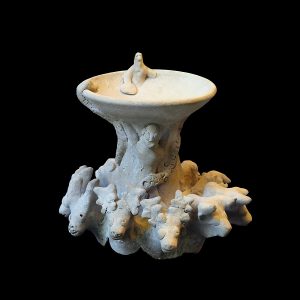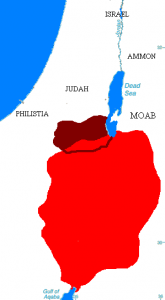Their buildings, to they extent that they can be called such, confuse the eye at first. Their superficial form is pure Greco-Roman classicism: columns, porticoes, and all. But the rock from which they are carved evokes an earlier, more primitive age. These are the famous monuments of Petra: creations of the Nabataeans, an Arab people that flourished for several centuries in the lands south of the Dead Sea.
The Nabataeans have one of those evocative names which, like the Sabaeans, Medes, and Sogdians, calls to mind an ancient and exotic world that we can never really know. They are truly alien: from a time before the great monotheistic religions swept the region, but outside the classical civilization of Greece and Rome. And yet they left behind a magnificent legacy. Stunning remains of their cities and tombs are dotted across the Near East, from the borders of Egypt and Syria to deep within the Arabian desert. Impressive fortifications, amazing rock carvings, and countless smaller artifacts attest to an urbane and cosmopolitan civilization that blossomed in the stony desert. This was something very different from the tribal desert life that they came from.
Pre-Islamic Arabia
Long before the great Islamic conquests made the Arabs a people of world renown, they had already made a name for themselves. Their lands stretched from the southern tip of the Arabian Peninsula to the deserts of Syria and Iraq, where they migrated with their flocks and herds from one well or oasis to another in a nomadic existence. Said to be descended from Ishmael, the son of Abraham by the handmaiden Hagar, they lived on the margins of civilization. The Arabs’ uneasy relationship with their sedentary neighbors echoed the tension of the Biblical story, in which Ishmael was exiled to the desert once Isaac was born. Though mostly peaceful and confined to trade, relations were also marked by mutual distrust and punctuated by wars.

There was not a hard-edged divide, of course. Desert nomadism merged into urban civilization along the fringes of Arabia, where some Arabs settled in towns and formed distinctive civilizations of their own. In the far north, the Kingdom of Palmyra arose in eastern Syria as a synthesis of sedentary Aramaic and nomadic Arab culture. In the culturally- and linguistically-distinct South Arabia, the Kingdom of Saba had been famous since at least Biblical times for the production of incense. Theirs was a settled society that maintained close links with Ethiopia and Indian Ocean kingdoms.
But the core of Arab culture was always in the desert, where tribal structures ruled their society. As is the tendency among tribal societies, they often formed large confederations. The great historical precedent for these tribal groupings was the Qedarites, said to be descended from Ishmael’s second son. Around the time of the Kingdom of Judah, this confederation ruled nearly all the desert between the Levantine coast and Mesopotamia. Their rule was effected by control of the oases that dotted the northern Arabian desert, which alone allowed such long crossings.
Two more famous examples of great tribal confederations existed just before the birth of Islam. The Ghassanids and Lakhmids guarded the Roman-Persian frontier against each other on behalf of their respective imperial allies. Each had kings and a capital city, but their true strength was in the network of alliances they had among the tribes stretching across a vast area. It was against this background of alliances of extended kinship groups out of which the Nabataeans emerged to form a splendid civilization of their own. How could a people from such a barren land achieve such amazing wealth?
Streams of Gold, Billows of Smoke
Not a hundred miles from the stony wastes of Petra is the Mediterranean Sea. This was another world entirely: the civilizations that lined its shores were among the most advanced on earth, ancient networks of cities that had existed since at least the Bronze Age. Their incredible wealth was advertised by their palaces and temples, filled with every opulence of the age. The structures themselves were magnificent: roofs of rich cedar beams were held up by veined marble columns. Their stone walls were adorned with statues or friezes on the outside and murals on the inside, and intricate mosaics stretched across the floors of the interiors.

No less magnificent were the people who frequented these structures. Men and women alike bedecked themselves in every imaginable finery: bracelets carved of ivory brought down the Nile, jewelry made of gems from Afghanistan set in Nubian gold filigree, amber and jade pendants. Their clothes were just as sumptuous, finely-spun fabrics dyed with Tyrian purple, laboriously extracted by Phoenicians from the shells of sea snails and sold for great sums by their merchants all around the Mediterranean. The richest of all wore silk, spun from the fibers of silkworms living in the mulberry trees of far-off China. A complex chain of merchants and intermediaries brought this precious fabric from the other end of the earth at fantastic expense.
Such splendidly-arrayed crowds might assemble for solemn sacrifices in the temple or joyous feasts in the palace hall. Mounds of delicious food would be heaped high on long tables, whether votive offerings to the gods or the many courses of a magnificent meal: dishes seasoned with spices from India and beyond, dripping in honey and sprinkled with pomegranate seeds. Dancers and singers would entertain the guests, accompanied by ensembles of double-reed flutes and tortoise-shell harps.

Luxurious sights, sounds, tastes, and textures. But the luxury of modern sanitation was beyond even the richest prince or priest. There was no escape from the stench of daily life: animal effluent, kitchen waste, and the smell of unwashed bodies pressed together under the hot Mediterranean sun. People used all manner fragrances to drown out the foul smells, from potpourris of flowers and herbs to scented wax. The best of all these measures was incense, made from various types of tree sap. The copious, sweet-smelling smoke it produced overwhelmed all other odors and gave an air of sacredness to the space it filled.

The most coveted was frankincense. It came from the olibanum tree, which only grows in southern Arabia and parts of Africa, and it produces a light, otherworldly smell unlike any other. Of all the senses, scent is the most powerfully connected to memories and emotions. It is not surprising then that frankincense should have been given such transcendental value by those of the ancient world. Its scent has always been associated with divinity, transporting those who smell it far from the muck of the mortal earth. The sweet smoke of frankincense once filled the pagan temples of the ancient world, and was readily adopted by Christians in the centuries after; today, it is used in ritual by Orthodox and Wiccans alike.

It was frankincense that made the Nabataeans wealthy. Their ability to endure the poverty and frugality of the desert allowed them to take control of the ancient desert trade routes, and so send caravans laden with valuable cargoes on thousand-mile treks across the Arabian Peninsula. Nearly all the frankincense consumed in Syria, Egypt, and the wider Greek world passed through the hands of Nabataean merchants at one point or another. It was not just the incense that made the Nabataeans wealthy. Yemen, in addition to being a large producer of incense, was one of the westernmost points in the Indian Ocean trade network. Spices and other seaborne luxuries from Asia passed through there, to be transshipped to the Mediterranean by Nabataean caravans, the last leg of a very long journey.
By Their Fruit You Shall Know Them
Many peoples had profited from the incense trade before, but the Nabataeans were lucky to come to prominence at a time when demand for their goods was increasing. They entered the historical record in the 4th century BC, when Alexander the Great brought the eastern Mediterranean under the rule of Greek-speakers. The cities of his former empire were dominated by a cosmopolitan upper class that consumed luxury goods in large quantity, as cities such as Alexandria, Antioch, and Pergamon competed for prestige. In the coming centuries, Roman domination would bring this extravagance to new heights.
Unfortunately, we have no clear understanding of Nabataean origins. Historical sources were written so long after their rise that at best they provide hints. The sheer number of possible explanations obfuscates Nabataean origins: descent from Biblical figures, tribes mentioned in Assyrian chronicles, etymologies from Arabic words. There is likewise scant trace of the early Nabataeans in the archaeological record. Their lifestyle in their homeland of the Arabian desert was dominated by the endless search for water and fresh pasturage; they left no inscriptions or other recognizable signs from this time. Only when they gained prominence do signs of their presence enter the archaeological record.

The only sure thing we can infer from their prehistory is that at some point they became involved in the incense trade. Good merchants seek to expand their share of the market, and for the Nabataeans this meant controlling more of the trade routes. Standing between them and the sea was an ancient people, known from the Bible as the Edomites. Edom ran along the valley between the Dead Sea and the Red Sea. This long depression, a southerly continuation of the Jordan River Valley, is guarded on its eastern flank by a massif of granite and sandstone. These mountains form a natural barrier to the deserts of Arabia: whoever controlled its tortuous passes could control the flow of spices to the west. Their position also allowed them to dominate the routes to Syria that ran along the east bank of the River Jordan.

The best anyone can fathom from the sparse historical record is that the Nabataeans, seeking to avoid taxes on their traffic, simply conquered Edom. They appear in former Edomite lands around the 4th century BC, a time when the Edomites were recorded as living in southern Judea. But the true story is murky. Desert societies tended to be confederations of intermarrying clans—it may be that the Nabataeans were in fact just a reconfiguration of tribal alliances. Whatever the case, the Nabataeans soon began to cohere as a political entity. They likely inherited many of their customs and machinery of state from the Edomites, the scribes, accountants, and toll-collectors that had allowed their predecessors to prosper. Thus armed, the Nabataeans entered the light of history in full splendor.
In Part 2, we will look at the Nabataean Kingdom, a state which expanded far in all cardinal directions from its capital at Petra.

